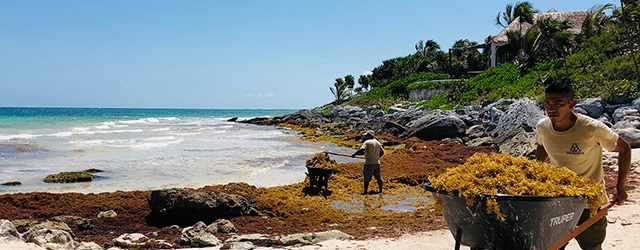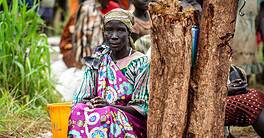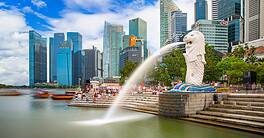The Caribbean’s long-term outlook hinges on diversifying out of tourism and commodities and turning climate change challenges into growth opportunities.

When the first-ever wave of Sargassum seaweed washed up on the coasts of the Caribbean in 2011, people took it in stride. But the Sargassum returned in larger volumes and affected more beaches year after year.
“It is almost definitely a combination of climate change and ocean enrichment with nutrients,” says Hazel Oxenford, a professor in fisheries biology and management at the University of the West Indies. “We are talking about nutrients from deforestation, urbanization, general continued land use and destruction of natural vegetation.”
The foul-smelling, decomposing piles of seaweed do not appeal to tourists. Pictures of fetid beaches have appeared on social media, tamping down demand for flights, hotels and restaurants.
Johanan Dujon, of St. Lucia, saw an opportunity outside the tourist industry. He began harvesting the seaweed and turned it into an organic fertilizer, founding Algas Organics in 2014. “I started this company with a vision to convert what many people saw as an environmental and economic threat into the world’s most innovative fertilizer company,” he explains. Algas Organics has processed more than 3 million pounds of Sargassum since starting production in 2015, simultaneously cleaning beaches and supporting local agriculture with an organic fertilizer.
The nations of the Caribbean have widely different sizes, histories, languages and levels of economic development; but they all share the same ocean and thus are suffering similar dramatic impacts from climate change. Creeping problems such as gassy seaweed are the least of it.
“As the 2017 hurricane season illustrated, powerful hurricanes, which will become more likely given warmer ocean water, can have a substantial impact on regional growth prospects—particularly given the generally volatile nature of tourism flows—in addition to risks such as greater flooding and changes in precipitation patterns,” says Andrew Trahan, country risk analyst at Fitch Solutions. “These downside risks will likely far outweigh the cost of adaptation over the long term.” Since Hurricane Maria wiped out Puerto Rico’s power grid, for example, public, private and philanthropic funds have invested in renewable energy, batteries and so-called microgrid infrastructure to build the island’s resilience. The efficacy of those measures was not fully tested by the milder 2018 hurricane season, Trahan notes. And it is not just the unpredictable weather, but also the economic and political impact of larger neighbors, such as the US, that make the Caribbean economies volatile and generally underperforming.
And with volatile economies, Caribbean countries are highly susceptible to shocks. “They can have a drought or a hurricane and the forecast can change by 0.5 percentage points, which is more relevant when growth is weak to start with,” says Juan Pedro Schmid, a lead economist at the Inter-American Development Bank (IDB).
World Bank CEO Kristalina Georgieva, in a blog post late in 2018, estimated the impact of hurricanes on small-island economies at 1.6% of GDP; add in other types of disasters, and the losses come to roughly 2.5% of GDP. The region’s long-term economic destiny is based on these countries’ ability to prepare for more severe weather challenges and perhaps even turn these extremes into growth opportunities.
IDB Lab, the innovation laboratory of the IDB Group, last year launched its Blue Tech Challenge to address these issues by identifying companies with business models that the bank says “use cutting-edge technologies to contribute to the sustainable management of oceans, marine ecosystems and coastal resources.” In March, Algas Organics, seeking to develop export capacity, was one of five companies chosen to receive funding out of 50 applicants.
“We recognize that invasive Sargassum seaweed is posing a real problem for the tourism sector, and we received several applications through the Blue Tech Challenge addressing this issue,” says Dora Moscoso from IDB Lab. “We selected Algas Organics because its technology had already been tested and it was seeking resources to expand and scale up its model.” Other winning proposals aim to help clean the oceans or improve fishing practices.
The Blue Tech Challenge is just one example of attempts to free the region’s economy from its two traditional mainstay industries: tourism and commodities. “Tourism is not the most dynamic industry,” says the IDB’s Schmid. “And there is a lot of all-inclusive [package] tourism that has little spillover to the general economy.”
“For the Bahamas, Jamaica and Barbados, it’s almost a puzzle,” says Schmid. “All three countries had the weakest growth for a long time. They suffer frequent external shocks, including in terms of weather, and they depend strongly on the US and Canadian economies.” Yet Jamaica can be called a success story.
“[Jamaica’s] debt-to-GDP has fallen, macroeconomic stability is entrenched, costs of borrowing are down, inflation is down, employment and job creation are at historical peaks, foreign exchange reserves are rising quickly, the business environment is improving and the economy has had 15 consecutive quarters of growth,” says Marla Dukharan, chief economist at Barbados-based fintech Bitt. She also offers praise for Grenada, which reduced its debt-to-GDP ratio from 108% in 2013 to 63% by the end of 2018. “Grenada just finished its sixth year of consistent and robust growth,” she says.
The Cayman Islands, too, are demonstrating resilience. In the first three quarters of 2018, the economy grew 3.6% ahead of same period the prior year and is delivering fiscal surpluses. “Their offshore economic zone, Cayman Enterprise City, has made significant advances towards becoming a hub for technology, aviation, maritime, commodities and derivatives businesses,” says Dukharan. “Health City Cayman Islands offers a myriad of medical specialties, many of which are not available anywhere else within the region.” At the same time, she notes, tourism—as measured by cruise ship arrivals and stayovers—grew 11% over the prior year. The Caymans also have a robust business as a friendly tax jurisdiction. “The number of new company registrations grew 34.5%, year over year, in the first nine months of 2018,” Dukharan adds.
Fitch Solutions sees economic growth in the Caribbean recovering to 3.9% in 2019 and 4% in 2020, up from 0.7% growth in 2018—the last an aberrant figure, Trahan points out, due to the fiscal year reporting of Puerto Rico, the region’s largest economy, because 2018 figures include part of 2017 with its hurricane aftereffects.
The IMF has been focusing on the Caribbean, following debt reduction in several countries, and suggesting financial tools aimed at reducing the risk of weather-related events. Alejandro Werner and Krishna Srinivasan, director and deputy director, respectively, of the Western Hemisphere department at the IMF, have supported the introduction of climate-resilient debt instruments as well as the Caribbean Catastrophe Risk Insurance Facility, a multicountry risk pool for government intervention during natural disasters. They suggest that debt contracts include “hurricane-linked clauses” to allow “an extension of maturity in the event of a natural disaster,” as well as the introduction of insurance to cover specific amounts of debt-service payments following catastrophic disasters.
The region is engaged in a wide range of efforts to boost economic growth, from renewable energy and medical marijuana to cutting-edge technologies such as blockchain. “Efforts to diversify away from tourism and commodity dependence are essential for sustaining economic growth, particularly given our view that growth in the tourism sector will slow in the coming quarters,” says Trahan. “Different markets in the region have taken different steps.” Barbados, the Bahamas, Jamaica, St. Vincent and the US Virgin Islands are betting on medical marijuana; Bermuda, the Cayman Islands, Curaçao and Saint Maarten are investing in blockchain technology; and Cuba, the Dominican Republic, Jamaica and Puerto Rico are putting energy into renewables, according to Trahan. Still, he does not think this will be enough to change the region’s long-term outlook. “These efforts are unlikely to be sufficiently advanced to break the region’s dependence on tourism to fuel economic growth,” he says.



